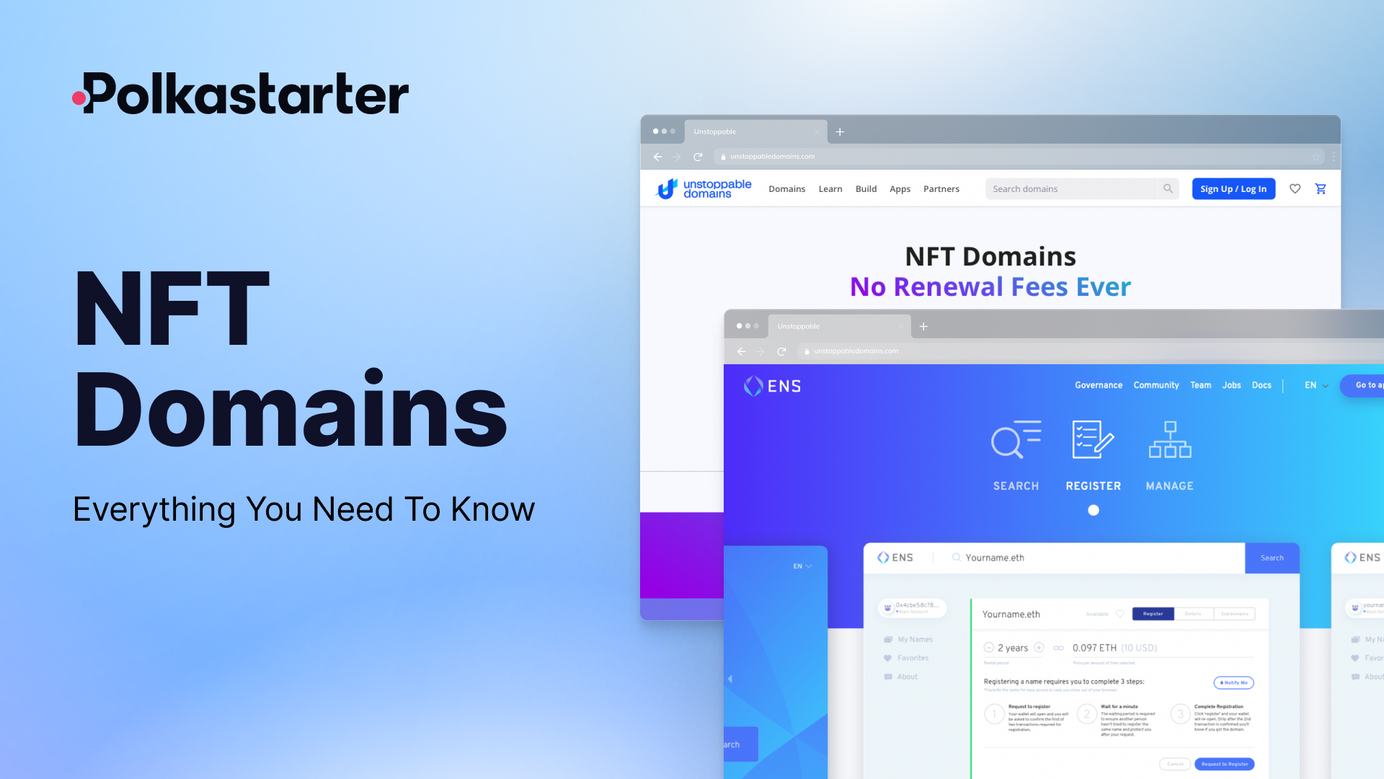
NFT Domains: Everything You Need To Know
Say hello to web3 websites
If you’re trembling at the thought of yet another NFT definition, fear not, as that is not what will happen here.
We’ve defined NFTs, talked about the future of NFTs, the future of NFT marketplaces, and even how to store NFT metadata. Today, we will talk about how NFTs are set to revolutionize the idea, architecture, and usability of website domains. Let’s dive right in.
How do web2 domains work?
While we all know what a website is, not many of us know much about what goes on behind the scenes to make websites work. What’s a domain, what’s website hosting, and what are TLDs? These definitions make up the entire web2 ecosystem as we know it.
A domain is a website address. It’s what we type in the address bar to access a website, e.g., https://www.polkastarter.com. Hosting refers to the storage of webpages in servers. To have a functioning website, you need both: a domain and hosting space. Normally servers can only be addressed by a unique IP-address which consists of numbers, but numbers are hard to remember. For this reason, you can register a domain name which maps to the IP-address of a web server.
Domain names consist of two main parts – a second-level domain (SLD) and a top-level domain (TLD). Second-level domains consist of words or phrases, while top-level domains are predetermined extensions. To give you an example, polkastarter.com, the second-level domain is polkastarter, and .com is the TLD.
Now that we’ve navigated through some definitions let’s shed some light on the governance of the current website system. To get a domain name for your website, you need to register it first. Where does that happen? Places like GoDaddy and Hostinger are domain name registrars. You simply insert the SLD and TLD in the domain name finder, and if it’s available, you can reserve the name for a certain time period. Usually, you need to renew the license yearly, but you can prepay up to 10 years in advance.
What’s important to note is that you’re essentially renting the name for a certain period of time, but never actually truly own it. Domains are listed under ICANN (Internet Corporation for Assigned Names and Numbers), an authority that coordinates and manages domain databases on the internet.
Why go to such great lengths to explain the structure and workings of website domains? To help you understand the level of change that NFT domains are about to bring.
How are NFT domains different?
NFTs are synonymous with digital ownership. Purchasing an NFT domain is no different, meaning you own your domain name instead of merely renting it out for a period of time, although you can choose to do that as well depending on the provider. NFT domains decentralize the traditional domain name registration system by running on smart contracts, removing centralized intermediaries and governing bodies.
The principal difference between the two website domain structures is ownership and authority. The internet as we know it today is essentially run by centralized organizations such as Google, Meta, and ICANN in exchange for personal information. In the case of domains, only a handful of companies control domain registration. NFT domains shift the power over to the user by running on decentralized blockchain infrastructure and smart contracts, presenting users with the opportunity to be the sole owners of a domain without intermediaries.
NFT domains benefits
While the main difference between web2 and web3 domains is ownership, there are more areas where NFT domains excel. NFT domains have more functions than simply being a website address. You can also map your wallet address to an NFT domain that will be easier to share and remember. Apart from simply displaying your content, they become the passport to accessing decentralized apps (dApps).
Some of the most popular web2 TLDs are .com, .net, .org. As you would expect, NFT domains come with different TLDs such as:
- .eth
- .nft
- .crypto
- .bitcoin
- .blockchain
Where could you possibly buy an NFT domain from? There are two reputable providers to date, Unstoppable Domains and Ethereum Name System (or ENS). These providers have different offerings: the first one will let you purchase your domain for life, and the second one will offer temporary registrations with limits higher than 10 years, which is the usual timeframe for web2.0 domains.
Here’s a summary of the powers afforded to you by NFT domains:
- Simplify crypto transactions by mapping wallet addresses to domain names
- Login to dApps with your domain name NFT as your universal web3 username
- NFT Domains run on decentralized infrastructure and smart contracts
- Trade your domains as NFTs freely without commissions
About Polkastarter
Polkastarter is the leading decentralized fundraising platform enabling crypto’s most innovative projects to kick start their journey and grow their communities. Polkastarter allows its users to make research-based decisions to participate in high-potential IDOs, NFT sales, and Gaming projects.
Polkastarter aims to be a multi-chain platform and currently, users can participate in IDOs and NFT sales on Ethereum, BNB Chain, Polygon, Celo, and Avalanche, with many more to come.
